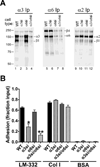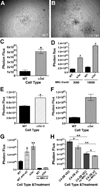Integrin α3β1 regulates tumor cell responses to stromal cells and can function to suppress prostate cancer metastatic colonization
- PMID: 23224938
- PMCID: PMC3604149
- DOI: 10.1007/s10585-012-9558-1
Integrin α3β1 regulates tumor cell responses to stromal cells and can function to suppress prostate cancer metastatic colonization
Abstract
Integrin α3β1 promotes tumor cell adhesion, migration, and invasion on laminin isoforms, and several clinical studies have indicated a correlation between increased tumoral α3β1 integrin expression and tumor progression, metastasis, and poor patient outcomes. However, several other clinical and experimental studies have suggested that α3β1 can possess anti-metastatic activity in certain settings. To help define the range of α3β1 functions in tumor cells in vivo, we used RNAi to silence the α3 integrin subunit in an aggressive, in vivo-passaged subline of PC-3 prostate carcinoma cells. Loss of α3 integrin impaired adhesion and proliferation on the α3β1 integrin ligand, laminin-332 in vitro. Despite these deficits in vitro, the α3-silenced cells were significantly more aggressive in a lung colonization model in vivo, with a substantially increased rate of tumor growth that significantly reduced survival. In contrast, silencing the related α6 integrin subunit delayed metastatic growth in vivo. The increased colonization of α3-silenced tumor cells in vivo was recapitulated in 3D collagen co-cultures with lung fibroblasts or pre-osteoblast-like cells, where α3-silenced cells showed dramatically enhanced growth. The increased response of α3-silenced tumor cells to stromal cells in co-culture could be reproduced by fibroblast conditioned medium, which contains one or more heparin-binding factors that selectively favor the growth of α3-silenced cells. Our new data suggest a scenario in which α3β1 regulates tumor-host interactions within the metastatic tumor microenvironment to limit growth, providing some of the first direct evidence that specific loss of α3 function in tumor cells can have pro-metastatic consequences in vivo.
Figures






Similar articles
-
Integrin α3β1 can function to promote spontaneous metastasis and lung colonization of invasive breast carcinoma.Mol Cancer Res. 2014 Jan;12(1):143-154. doi: 10.1158/1541-7786.MCR-13-0184. Epub 2013 Sep 3. Mol Cancer Res. 2014. PMID: 24002891 Free PMC article.
-
Comparative use of CRISPR and RNAi to modulate integrin α3β1 in triple negative breast cancer cells reveals that some pro-invasive/pro-metastatic α3β1 functions are independent of global regulation of the transcriptome.PLoS One. 2021 Jul 16;16(7):e0254714. doi: 10.1371/journal.pone.0254714. eCollection 2021. PLoS One. 2021. PMID: 34270616 Free PMC article.
-
Knockdown of cathepsin B and uPAR inhibits CD151 and α3β1 integrin-mediated cell adhesion and invasion in glioma.Mol Carcinog. 2013 Oct;52(10):777-90. doi: 10.1002/mc.21915. Epub 2012 Apr 11. Mol Carcinog. 2013. Retraction in: Mol Carcinog. 2021 Oct;60(10):717. doi: 10.1002/mc.23342. PMID: 22495828 Free PMC article. Retracted.
-
Integrin α3β1 as a breast cancer target.Expert Opin Ther Targets. 2011 Oct;15(10):1197-210. doi: 10.1517/14728222.2011.609557. Epub 2011 Aug 13. Expert Opin Ther Targets. 2011. PMID: 21838596 Free PMC article. Review.
-
Roles for epithelial integrin α3β1 in regulation of the microenvironment during normal and pathological tissue remodeling.Am J Physiol Cell Physiol. 2024 May 1;326(5):C1308-C1319. doi: 10.1152/ajpcell.00128.2024. Epub 2024 Mar 18. Am J Physiol Cell Physiol. 2024. PMID: 38497112 Free PMC article. Review.
Cited by
-
A Novel Overall Survival Prediction Signature Based on Comprehensive Research in Prostate Cancer Bone Metastases.Front Med (Lausanne). 2022 Jun 16;9:815541. doi: 10.3389/fmed.2022.815541. eCollection 2022. Front Med (Lausanne). 2022. PMID: 35783639 Free PMC article.
-
Integrin α3β1 can function to promote spontaneous metastasis and lung colonization of invasive breast carcinoma.Mol Cancer Res. 2014 Jan;12(1):143-154. doi: 10.1158/1541-7786.MCR-13-0184. Epub 2013 Sep 3. Mol Cancer Res. 2014. PMID: 24002891 Free PMC article.
-
The Emerging Role of Cell Adhesion Molecules on Benign Prostatic Hyperplasia.Int J Mol Sci. 2023 Feb 2;24(3):2870. doi: 10.3390/ijms24032870. Int J Mol Sci. 2023. PMID: 36769190 Free PMC article. Review.
-
Absence of integrin α3β1 promotes the progression of HER2-driven breast cancer in vivo.Breast Cancer Res. 2019 May 17;21(1):63. doi: 10.1186/s13058-019-1146-8. Breast Cancer Res. 2019. PMID: 31101121 Free PMC article.
-
Integrin-associated CD151 is a suppressor of prostate cancer progression.Am J Transl Res. 2020 Apr 15;12(4):1428-1442. eCollection 2020. Am J Transl Res. 2020. PMID: 32355552 Free PMC article.
References
Publication types
MeSH terms
Substances
Grants and funding
LinkOut - more resources
Full Text Sources
Medical

